If you run a shop with a lot of products and your category pages also contain a text, the question arises: How do I properly deal with pagination within the framework of SEO?
Websites with a large amount of content and information are often divided into so-called component pages. This pagination poses severe challenges about the correct indexing of the website content.
You should be aware that there is only one way to use it. We will show you the right way and how you should NOT use it to control your pagination.
Why Is Pagination Important?
The pagination helps you to organize your page and to distribute your crawl budget correctly. As already described, e-shops with many products are predestined for pagination. But other page types can be used:
- News on topic pages
- Overview pages of doctor searches
- Event pages
- Etc.
Many Content Management Systems provide pagination by default. In most cases, however, this is not suitable for SEO. Some pages are not even indexed. Thus, always check what your e-shop or CMS system offers you, and decide whether you still have to do something from an SEO perspective. In most cases, thanks to PHP, these systems can be easily adapted to SEO suitability, so that nothing stands in the way of a successful ranking.
NEVER “noindex” From Page 2
If you run an e-shop, you should always pay attention to how it is indexed. It was often discussed and written; it should build “noindex, follow” from page 2 into the <head> of the website. This works for some time, but it has a negative effect. In the long run, the search engines also impose a “noindex, nofollow” on page 1 and refer all pages from the index. Therefore, please NEVER noindex from page 2.
Using rel=”prev” and rel=”next”
The use of rel=”prev” and rel=”next” for pagination has prevailed for many years. Google launched this use in 2011 and touted it as a viable pagination solution. But now this has come to an end. On March 21, 2019, John Müller from Google stated that Google no longer uses this variant. Hence, rel=”prev” and rel=”next” are irrelevant for Google. However, we recommend using this setting because other search engines such as Bing continue to use them. These will not harm Google ranking. In a Twitter statement, John Müller announced that the relevant documentation was removed from the Google portfolio.
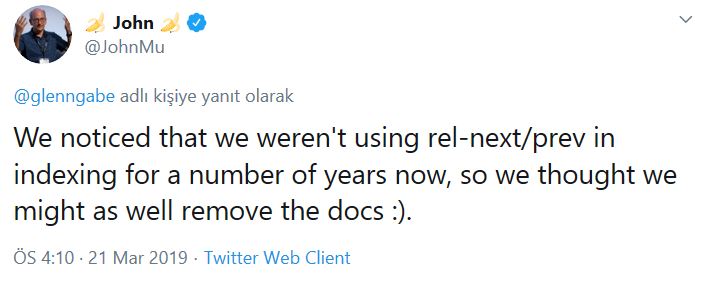
Müller also made it clear that most pages work without these settings.
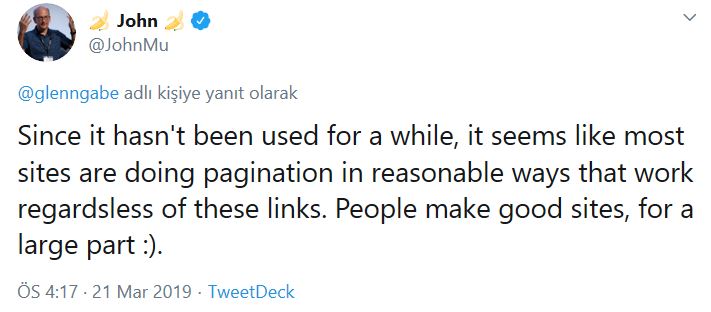
Use of Canonicals for Pagination
Many website operators and SEOs thought many years ago that they could control pagination using canonical tags. But this is a crude mistake. The e-shop operators have set a canonical on page 2 of the category, referred to page 1. This is not practical. Canonicals are used only to canonize pages with almost identical content. An e-shop is a different product, so each page stands alone within the category. Here it is always important to let the Canonical refer to itself.
Integration of Parameters in the Context of pagination
A practical solution using Canonicals is to use additional parameters. So a parameter with the respective page number is appended to the actual page.
Random e-shop: https://www.randomeshop.com/cagegory1/ –> Main Page https://www.randomeshop.com/category1?page=2 –> Page 2, incl. parameters
Adding parameters makes it much easier to control a page with the parameter handling in the Google Search Console. Also, via the Disallow command in the robots.txt, the sub-categories can be easily excluded from the index.
Pagination Using AJAX and JavaScript Scrolling
Scrolling endlessly on the page and the products repeatedly reloading again is hugely annoying. When scrolling, the URL changed so that a parameter value was added, even though you always stayed on the same page. Whenever the products are reloaded using JavaScript and AJAX, text, and the particular footer disappear further and further downwards and can never be reached. Reloading the products via AJAX and JavaScript is not bad but should be used differently and, above all, more sensibly. There is a “More” button. By clicking on a “Show more products” button, the products can be easily reloaded after clicking with AJAX and JavaScript. This helps everyone who wants to see more products. The website visitors who wish to keep the preset number of products can easily reach the category text and the footer.
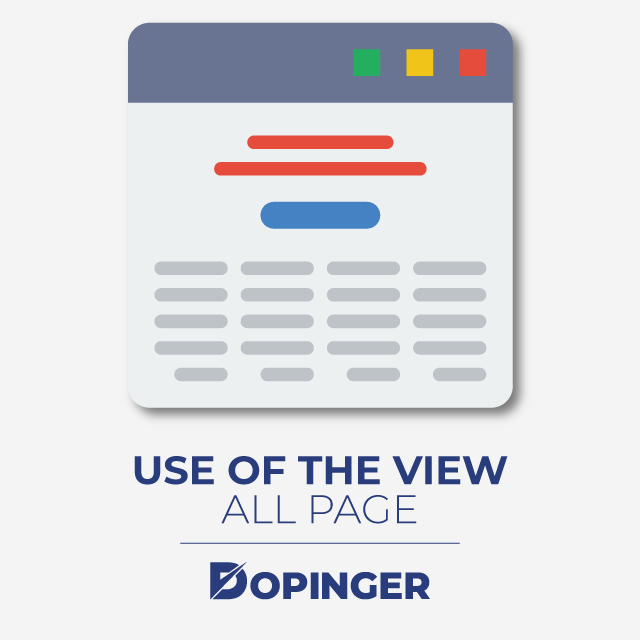
Use of the View All page
This page summarizes all products that exist in a category. With the help of lazy loading, the products can be reloaded dynamically. To do this, each component page, i.e., each paginated page, must point to the “view-all page” using Canonical. From a usability point of view, this variant is not suitable. The View-All is just a gimmick to show Google all the products that are available within a category. We don’t believe in this variant. If we want to share the products of a category with Google, we do it via the sitemap. This can then also be used to precisely control which products the bot should view and which should not.
Duplicate Content When Paginated
In addition to excluding the parameter pages, duplicate content can be quickly remedied. However, there are other ways to avoid duplicate content. If you want to have all pages, including those with parameters in the index, you must pay attention to individual metadata. A plausible but straightforward solution is to use a counter. It is sufficient to add the page in brackets.
Random e-shop:
Cheap shoes from the brand XYZ -> page 1
Cheap shoes of the brand XYZ (page 2) -> have the value of the clip count up with a counter.
This setting ensures a unique page title and prevents duplicate content as part of the pagination. It should also be noted that if a text has been included in the category, it can only be found on the first page. The programmer within the template best sets this. The programmer must program a corresponding query for this.
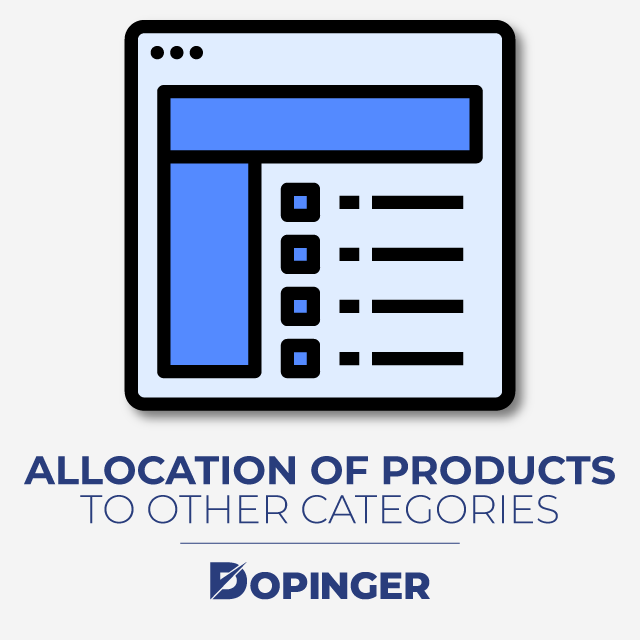
Allocation of Products to Other Categories
For avoiding pagination, you can use a keyword map to determine the small categories into which the products can be divided. Of course, other smaller pages are created this way, but this doesn’t have to be a disadvantage. Thanks to this more efficient division, you can use an optimized category text
Conclusion
As already described in the previous points, you need to consider various things when paginating. First of all, you should think about how many subpages you want to have in each category. This raises the question of what is the number of products per page. The more products you display, the fewer subsequent pages you will build. For the main page, however, you have to be aware that more products also means that the category text below the products is located more below and will be more difficult not only for the reader but also for the bot.
Our recommendation is to limit yourself to the bestsellers on the main category page and thus to a smaller number of products. You can then deliver the pagination pages with the largest possible number of products since you will no longer have the category text appear. Work with self-referencing canonicals, unique metadata, inserting the page number in the title and description, and the elements rel=”prev” and rel=”next”. Google no longer considers those for better processing with other search engines, such as Bing and Ecosia, whose search results are based on Bing.
Frequently Asked Questions About
Client-side pagination is when the server sends all available records to the client. These results then are split into several pages and rendered on the client-side, with JavaScript. Changes pages or ordering items becomes almost instant, and requires no server interaction. Which is much easier to cache on the server side.
A canonical tag is a way to tell search engines that the specific URL represents the master copy of a page. Using canonical tags prevent problems caused by duplicate content appearing on multiple URLs.
Canonical tags affect SEO in two points of view. It can both directly influence search results and canonicalizing pages also result in a general boost in rankings.

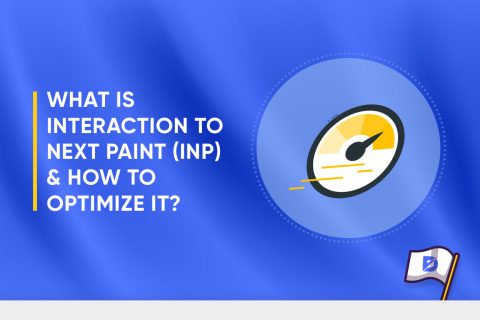
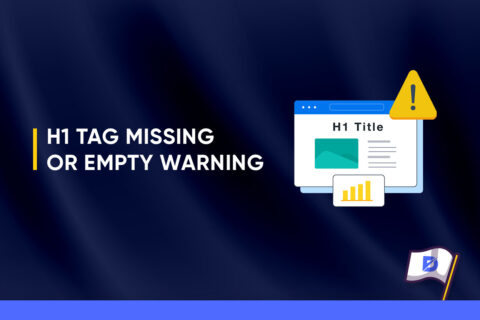
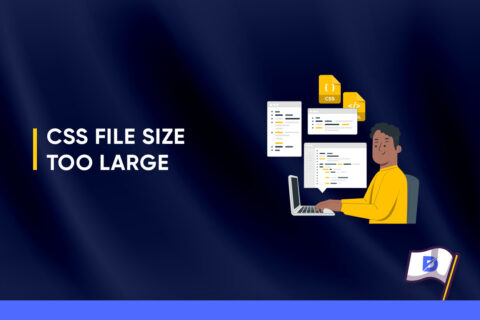

No comments to show.